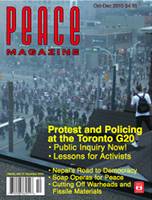
Peace Magazine Oct-Dec 2010, page 26. Some rights reserved.
Search for other articles by Lyn Adamson here
Leading up the G20 in Toronto, the Community Mobilization Committee stuck to this view: all groups whose events would be publicized by the mobilization had to agree to support the use of diversity of tactics, with no criticism of other protesters’ methods allowed.
Based on prior G20 experiences, that would mean street protests with property damage—broken windows and burning police cars. And based on prior G20, one could also expect police brutality. And Toronto got it all.
But did it have to be that way? Less than 0.5 percent of protesters engaged in any kind of property damage; 99.5 percent were simply engaged in peaceful protest, including the 25,000 who came out to the main march and those who attended protests in the week leading up to the summit. These were all nonviolent, with creative street theatre, speakers, and entertainment. Indigenous elders called for no masks and no violence during their march, and provided peacekeepers to ensure no disruptions.
In contrast, black-clad protesters used the cover of the main march to start smashing windows of downtown merchants and moved on to burning police cars. Despite an unprecedented $1 B spent in “security” this vandalism occurred and burning police cars became the signature image of the protests, splashed onto TV screens across the country. No mention that the cars were left abandoned for hours in downtown intersections, and no mention that fire trucks were not permitted in to extinguish the fires, while media was given full access.
How is it that about 100 black-clad people were able to create havoc in Toronto’s streets, with thousands of police officers just steps away from them? The shock was that police were ordered to stand back. For hours the mayhem continued, which could have easily been stopped. About half an hour after the vandalism stopped, the arrests started, with police sweeping in on the free speech zone at Queen’s Park.
Arrests continued over the weekend, along with such measures as keeping hundreds of people kettled1 for hours in torrential rain. That is, they were surrounded and not permitted to leave except under arrest. Detentions topped 1,000 people—the largest mass arrest in Canadian history. The protests in Toronto gained the moniker “The Toronto Riot.”
Yet it was nothing of the kind. To suggest so is a fraud perpetrated on the country, which shows the measures this government is willing to take to shape public opinion. The whole event was choreographed by the Integrated Security Unit of the RCMP. Organizers went along for the ride, claiming it was just not right to criticize any protesters’ actions, even when those actions played directly into the image the government wanted to create. This contrasts to the protests in Montebello when organizers made sure the event remained nonviolent and de-masked police infiltrators in front of media cameras.
What was the effect of being able to portray the protests as violent? Harper’s popularity soared. Criticism of the expenditure on security, which had been growing before the summit, disappeared. He was able to justify the cost. While those of us in the activist world know that there was no justification for this expenditure of funds, which could have funded housing and food programs, transit, or renewable energy, benefiting our communities, the mass of ordinary Canadians across the country, watching mainstream news, would not understand this at all. Instead, the tremendous loss of civil liberties could now be justified by “violence,” with police actions portrayed as reasonable. Without a full-scale inquiry that is how they will continue to be seen.
This comes at a huge cost to the activist movement, which must raise funds to defend protesters—including those arrested on serious charges. This drains energy and money from such activist campaigns as shutting the tar sands and building a new green infrastructure—changes required for reducing carbon emissions and slowing global warming.
The use of vandalism in protests is at odds with our cultural values as peacebuilders. A change from violence to nonviolence is essential for building a society that meets human and environmental challenges without wasting resources by subsidizing banks and corporations. If we want a society that values life over profit, our means must be in harmony with this purpose.
Nonviolent action can be powerful. Mass nonviolent mobilizations have succeeded in replacing dictatorships (Serbia, the Philippines, Chile), ousting imperial regimes (India), and achieving civil rights in the US and South Africa.
In India Ekta Parishad launched a month-long march for justice in 2007, mobilizing 25,000 in a demand for land rights. They are now organizing a march for 2012, mobilizing 100,000. All will be trained in nonviolence. They invite groups around the world to join them; in at least 60 countries solidarity marches are planned. Will Canada be one of them? To get involved, see ektacanada.weebly.com.
Lyn Adamson (ladamson@primus.ca) is Coordinator of PeaceWorks, a project of Toronto Friends Meeting, co-sponsored by Canadian Voice of Women for Peace, Greenspiration, and Nonviolent Peaceforce Canada. PeaceWorks offers training in communication and nonviolent social transformation. See: www.vowpeace.org. Video footage from the G20 can be found at: www.therealnews.com. Also, www.rabble.ca discusses the protest tactics.
1 Kettling is a police tactic of blocking an area on all sides, allowing no one to exit without arrest. It was also used by British police during the London G20 protests, where it led to the death of a passserby.

Peace Magazine Oct-Dec 2010, page 26. Some rights reserved.
Search for other articles by Lyn Adamson here